

Getting a great VR experience can be intimidatingly expensive at the best of times. But for our lucky VROne readers, we’ve made it simple to get the best Black Friday 2020 deals. We’ve developed a web page that has collated this year’s hottest tech, featuring real-time price updates.
VR NewsGetting a great VR experience can be intimidatingly expensive at the best of times. But for our lucky VROne readers, we’ve made it simple to get the best Black Friday 2020 deals. We’ve developed a web page that has collated this year’s hottest tech, featuring real-time price updates.

After a record-breaking summer, autumn is finally here. The days are getting shorter, and our typical British weather has made a rousing comeback. Somehow, we’ve already found ourselves in October - and we all know what that means: Black Friday 2020 is right around the corner! Us tech-heads at VROne have been waiting for the chance to snap up new gear in the Black Friday sales all year. Currys Black Friday deals and the Amazon sales are always eagerly anticipated by gamers, all hoping for the biggest discounts and best Black Friday deals.

Benefits to Our Readers
Getting a great VR experience can be intimidatingly expensive at the best of times. Just getting started with a decent headset is quite the investment, and the numbers only rise once you start looking to upgrade. The Oculus Quest 2 headset, for example, is one of this year’s hotly anticipated HMDs, comes in at a cool £299. The prices on graphics cards, motherboards, CPUs, SSDs and RAM components - and even VR accessories can add up to a frightening amount.
But for our lucky VROne readers, we’ve made it simple to get the best Black Friday 2020 deals. On our home page, we’ve collated this year’s hottest tech, featuring real-time price updates. Better yet, you can sign up to receive notifications for price drops for as many or as few categories as you like: we have pages for just about everything gaming related. Our home page provides a look at real-time prices and allows you to subscribe for updates on VR headsets, graphics cards, CPUs, SSDs and RAMs, and accessories. Case in point: at the time of writing, NVIDIA’s new graphics cards, the RTX 3080 and 3090 are going for an eye-watering £673.49 and £2851 respectively. A high-quality GPU can make all the difference to your rig, but don’t jump the gun and burn a hole in your wallet! Make sure you sign up to get the best possible savings.
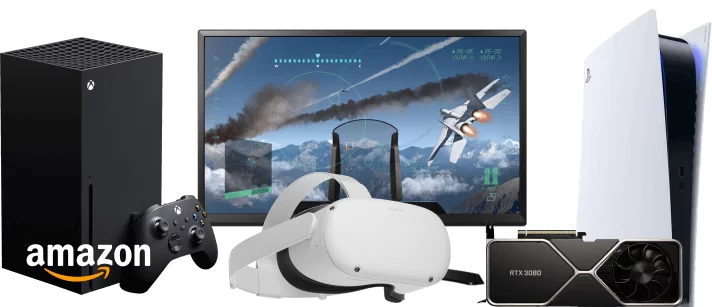
Some more of the big-ticket items that are sure to fly off the shelves this year are the Xbox Series X and PlayStation 5. As always, we’ve got you covered: click here for the price updates pages on consoles and game bundles.
Don’t be conned into paying full price: by subscribing, you know you’ll be getting the best VR deals on everything from headsets, the latest camera's, Smartphones, Laptops and Tablets, graphics cards, gaming monitors and TV's on the Amazon Black Friday sales.
Once you’ve signed up, you can rest assured that you’ll be getting the best Black Friday 2020 deals for all of the tech you’ve been lusting after this year. I mean, if we’re on the road to another national lockdown soon, surely we’ll all need some new gadgets to stave off the boredom!
Now that we’ve taken a look at what Black Friday 2020 could mean for you, let’s take a step back and explore how this remarkable retail holiday has blossomed into the global phenomenon it is today.
The First Black Friday
In the United States, the first day after their Thanksgiving celebration (celebrated on the fourth Thursday of November) unofficially marked the start of the Christmas shopping season. This would coincide with extravagant Christmas parades sponsored by department stores, like Macy’s; a tradition that has continued to this day. However, the first known use of “Black Friday” in the early 1950s didn’t have the same connotations of the extreme bargains we’re now familiar with. In fact, the Philadelphia and Rochester police used this term to describe the now-expected chaos that accompanied the start of the Christmas shopping season. To add to the excitement were tourists flooding in from across the country, to watch the annual army vs. navy American football match held on that Saturday every year. Records from this time indicate the extent to which the local police forces were overwhelmed by eager discount-hunters: officers were stretched so thin by the huge amounts of traffic and crowd management that several more cunning shoppers took advantage of the confusion to steal merchandise!
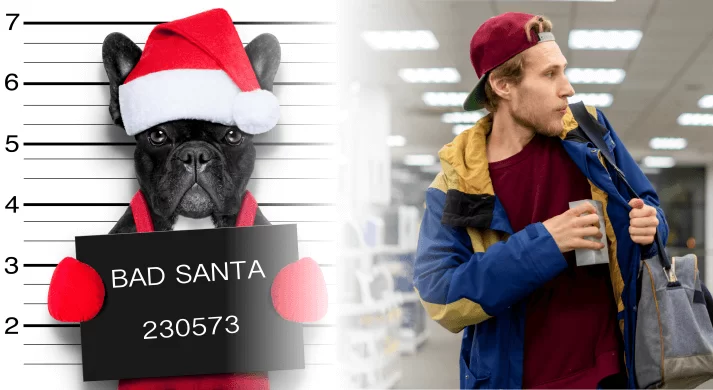
Black Friday From the Past to the Present
The 1980s-1990s
The negative connotations of Black Friday stuck until the 1980s, at which point retailers successfully managed to associate it with a cleaner image. Instead of invoking the absolute bedlam of busy Christmas shoppers, they instead claimed that it referred to businesses, after operating at a loss for the majority of the year (being ‘in the red’) becoming profitable again with the advent of the holiday season (being ‘in the black’). This marketing ploy has since been hugely successful, with Black Friday becoming a staple of the American calendar.
The 2000s
Black Friday reached a staggering fever pitch at the start of the 21st century. Some retailers were desperate to extend the bargains for as long as possible: opening times creeped backwards, finally reaching midnight. This wasn’t enough for some: in 2009, K-Mart was the first to start promoting its Black Friday deals at 7 o’clock on the Thursday morning of Thanksgiving. The sarcastically-known ‘Black Thursday’ inspired several copycats, to the extent that some shop employee unions started calling for strikes. Eventually, some states outlawed such stores from opening on Thanksgiving, in order to respect workers’ right to enjoy the holiday.
The extreme Black Friday deals have inspired some unsettling behaviour amongst shoppers. In their desperation to snag the best bargains, there have been numerous reports over the years of shoppers camping outside big department stores to make sure that they’re first in line. Tensions run high as shoppers vie for - and occasionally brawl for - the products they’re after. The unsettling Black Friday Death Count paints a bleak picture. From 2006 to 2018, there have been twelve deaths and over one hundred injuries, all over something as inconsequential as discounted toys. Stories of fatal shootings, stabbings, and brawls pepper this list.

The 2010s
With the growing popularity of Youtube at the start of the decade, journalists and ordinary passersby alike could document this reported antisocial behaviour for themselves. A cursory search reveals the insane crushes of crazed shoppers flooding into stores. With all due respect to our friends across the pond - these videos seem only to confirm some of the worst stereotypes of American materialism.
One video that’s racked up three million views - heralded by user “prowlandsasuke” as “the calmest Black Friday video I’ve ever seen” - follows the start of Black Friday at a Super Target store in Utah. The video starts filming at 03:45, showing trepidatious employees preparing for the incoming glut of customers. They’re standing by hundreds of shopping trolleys. The journalist documenting the day asks “Think there’ll be enough carts?”. An employee shrugs: “Maybe.” The doors unlock at 04:00, where shoppers have already been queueing for hours in the freezing November weather. Whooping and shrieking, the first customers race in to grab their carts. Trolleys loaded up with Christmas presents, they quickly drain the displays. A store manager announces that anyone looking for a Wii Fit can go to the back corner of the store, where employees have started handing out the consoles straight from the stockroom. Despite the relative calm, one young woman reports that she’s been hit in the face with someone’s shopping bag.
The next video I found proved “prowlandsasuke”’s words to be prophetic. A 2018 clip from ABC News highlights the worst of Black Friday scenes from that year. After a brief introduction from the presenter, they roll footage of a Tennessee Victoria’s Secret shop being bombarded with bargain-hunters. You get the impression that this is the featured employee’s first year working on Black Friday: her features are marred with shock as the customers start to flood in. Those at the front are aggressively shoved forward by eager shoppers at the back of the crowd, prompting shouts of frustration before any of them have even set foot inside the store. The beleaguered saleswoman ends up climbing onto a display table of leopard-print negligées in an attempt to avoid the crush, shrieking “Oh my God!!” as the chaos unfolds around her. The next clip they show is so absurd that I felt caught between schadenfreude and horror, as two women in a Georgia Walmart fight over a box of cooking wares. In her determination to get these potentially life-changing frying pans, one woman refused to let go of the box - resulting in her being dragged across the floor by a similarly enthusiastic shopper. The people around them mimic my own feelings: you can hear gasps of shock and cackling in equal measure. Next, the newscaster describes an Alabama fight that escalated into a shooting. Amongst the injured and dead, was a twelve-year-old girl caught in the crossfire. It seems that the violent frenzies seen in many parts of the country weren’t enough to deter shoppers: approximately 116 million determined discount chasers braved the crowds and the winter weather that year.
Up until the early 2010s, Black Friday in the sense of a retail holiday had been a strictly American phenomenon. However, it eventually began to spread across the globe. Across the pond, the British police and NHS had their own version, more akin to the Philadelphia police’s original definition. In their eyes, Black Friday was, and still is, the harrowing Friday before Christmas, where hospitals and city centres are overrun by drunken office and factory workers emerging from boozy Christmas parties. In some areas, it’s even been called Black Eye Friday, for the huge number of pub and street brawls it excites.
In Britain, the biggest shopping day of the year was traditionally Boxing Day, the day after Christmas. However, at the start of the decade, British businesses with ties to the US realised the extent to which they could profit from implementing this sales strategy. Inspired by retailers like Amazon UK, and (at the time) Walmart-owned Asda, companies like John Lewis, and Argos began running extreme promotions on the post-Thanksgiving Black Friday. Unfortunately, with American-style discounts came American-style behaviour, with waves of customer aggression, heaving crowds, and gridlocked traffic. One harangued police chief described the public’s behaviour as simply “appalling”.
Environmentalists
The materialism that Black Friday inspires has brought on criticism from a number of quarters. Environmental campaigners, horrified by the - and I don’t believe this is too strong a word - greed that the retail holiday can inspire in the ordinary person have decried the environmental damage caused by such excessive demand, and the overproduction it entails. Again, we can look to the ABC News video that I referenced earlier; in one clip, we see shoppers grabbing TVs. One man has four of the same model in his trolley! The reporter states that the average consumer expected to spend over a thousand dollars on Black Friday alone that year.
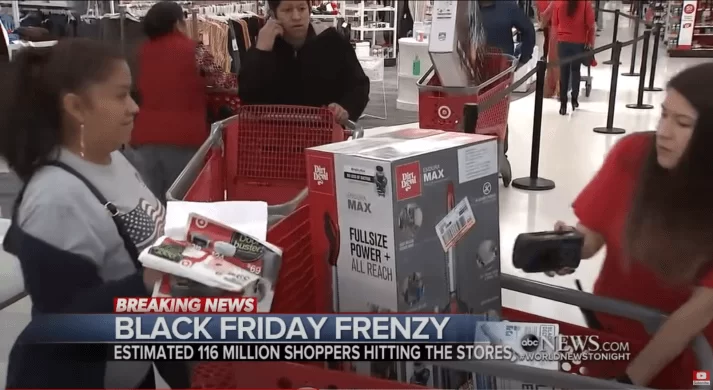
Notable protests from Canada, France and Great Britain have decried this excessive consumerism. Many cite the disturbing UN report that 50 million tons of electronic waste is created each year by the modern phenomenon of tech’s increasingly short shelf-life. TVs, tablets, and phones are regularly re-bought and binned for meagre upgrades, with only the alluring cachet of the new to recommend them. Environmentalists have decried the pollution and use of resources caused by such excessive consumption, calling for shoppers to save their money - and the planet - by boycotting the retail holiday.
The French activist group “Amis de la Terre” (Friends of the Earth) has a page on its site dedicated to the many ills of Amazon (named: “Amazon vend tout, même la planète!” or, “Amazon sells everything, even the planet!), and listing their efforts to stem the retail giant’s expansion. On Black Friday last year, fifty two members of their group piled fifteen square metres of rubbish in front of an Amazon warehouse. Their aim was to criticize both Amazon’s cut-throat pricing, and to call attention to their lawbreaking. Around the same time, a collective of French brands banded together to start the “Make Friday Green Again” movement, which proposed to take a stand against the retail holiday. They pledged to do away with the discounts and instead donate 10% of their profits to charity. Unsurprisingly, this has largely remained a minority movement, but it did strike a chord with some international companies, such as skincare brand DECIEM. In a savvy move, DECIEM walked the line between bowing to growing environmental concerns while still tempting shoppers with reduced prices. Amusingly, a paragraph primly stating that the company “no longer feel[s] that Black Friday is an earth or consumer-friendly event” and that they will thus “close our website and stores for a moment of nothingness on the 29th November” is preceded by one advertising that “a 23% discount is now available across every product and every brand at DECIEM.com...for the next month”.
Across the Channel, Britain has seen its own share of Black Friday-related activism. On Black Friday 2019, Extinction Rebellion’s Swindon Chapter decided to hold a “die-in” at the local Outlet Village. The protesters planned to depart this plane for only a “short while” before reviving themselves to pester shoppers one final time with loud singing as they left.
Anti-consumerists
Activists against consumerism have been rejecting Black Friday’s commercial exuberance long before the world had ever heard of Marie Kondo. In 1991, Vancouver artist Ted Dave founded the first Buy Nothing Day, held the Friday after Thanksgiving. As the name implies, Buy Nothing Day attempts to encourage shoppers to resist the temptation to indulge in Black Friday deals and to think more critically about their spending habits. Supported by Canadian anti-consumerist group Adbusters, Buy Nothing Day has seen people cutting up their credit cards in front of department stores, sit-ins and even zombie walks: these involve shuffling and groaning through shopping centres. When the zombies are interrogated, they reveal that they’re there to promote Buy Nothing Day. One would also imagine that they are rudely impersonating the shopping habits of the mindless consumer. Buy Nothing Day, while not having anywhere near the level of impact as Black Friday, has seen some adoption abroad. National chapters have been set up in Argentina, Bosnia and Herzegovina, Denmark, Japan, Romania, Holland, Sweden and Britain (countries without links have now-defunct websites).
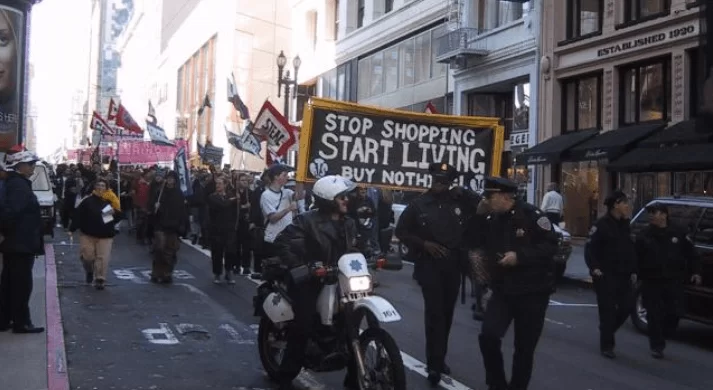
Although Buy Nothing Day in itself hasn’t made the great waves in anti-consumerism that it has hoped for, the 2010s have seen an increasing movement against thoughtless purchases and retail therapy. The online conversation has shifted towards minimalism and mindful purchasing. Environmental activism has dovetailed nicely with these trends, with influencers of all stripes claiming that they’re consciously amending their shopping habits out of environmental concerns. The zero-waste movement in particular is notable for how well it links to anti-consumerism, with its emphasis on purchasing less - or ideally, nothing at all - more sustainably.
Particularly in the States, where as I’ve previously noted, spending habits consistently outpace the rest of the world, there has been a long-awaited backlash against maximalist purchasing. A lot of this digital debate centres around the concept of “fast fashion” - a business practice in which many highstreet, and even high-end brands produce ever-increasing volumes of cheap, near-disposable clothing to satisfy customers’ Instagram-fuelled appetite for trends. Around this time, a previously unknown Japanese organizing consultant, Marie Kondo, found international acclaim with her global bestseller The Life-Changing Magic of Tidying Up. Despite the title, one of the core takeaways of this book was to only keep what truly “sparks joy”. Her modest proposition took the world by storm, with influencers going through their hordes of possessions (particularly clothing) in “decluttering” videos. One such video, by Youtuber Laura Lee, takes the viewer on a thirty minute-long journey as she sorts through her mountainous makeup collection. Viewers, many of whom don’t have such extreme habits, gain a sense of satisfaction from watching the - ahem - cluttered space become gradually pared down. For the grand reveal: a satisfyingly organized array of drawers and shelves, alongside bin bags of items to donate or throw away. Many of these viewers have been inspired to do the same with their own homes, leading to a surge in charity shop donations. Though - ironically for those who claim to be motivated by environmental concerns - these declutters can generate more landfill waste in the short term. However, the clean, empty aesthetics of minimalism have prompted a growing number of young people to think twice about their spending habits.
With the backdrop of bedlam surrounding Black Friday in traditional shops, digital retailers saw an ideal solution for themselves and customers: they would offer a wide range of competitive Black Friday deals without any of the hassle for shoppers of a physical department store.
There have been a variety of distinct promotional days inspired by Black Friday, such as Ebay’s Green Monday and Cyber Monday. The best-known example is likely to be Amazon Prime Day, first held on July 15th 2015 to commemorate the corporation’s twentieth anniversary. As the name suggests, Prime Day featured exclusive deals for Amazon Prime customers. In an attempt to lure shoppers, the company attempted to distinguish itself from its predecessor, claiming that it would have “more deals than Black Friday”. Despite initial consumer disappointment in the quality of the discounts offered - many of which were allegedly tied to products that were not in high demand - Prime Day has continued to be a draw for people looking to splash out for the summer.
At the outset of the increased digitization of Black Friday shopping, many companies began to invest heavily in promoting their online shops. Pummelled by incoming traffic, many found that their websites couldn’t cope with the onslaught and went down - ironically leading to a loss of revenue for many.
Despite this initial divide between physical and digital retailing efforts, as time has gone on there’s been increasing convergence between the two groups. Now, many online stores offer both Black Friday and Cyber Monday (even Cyber Week!) promotions, to expand the window for price-conscious shopping for as long as possible. As a result, the importance of Black Friday’s physical presence has diminished significantly, with ever-increasing numbers of consumers preferring to shop online. Undoubtedly, Black Friday 2020 will see record levels of online shopping, thanks to the continuing Covid-19 restrictions that we’re seeing around the world.
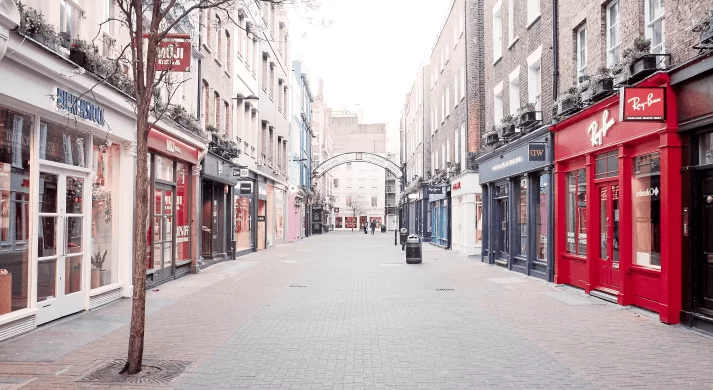
Although Black Friday is still a powerful force in the retail industry today, over time it’s lost much of its original meaning. Thanks both to shops opening in advance on ‘Black Thursday’ and the continued importance of digital shopping, Black Friday has become more of a catch-all term to describe the lengthy bumper sales we now see annually; particularly in the many countries which don’t have the context of the Thanksgiving tradition.
Black Friday has come a long way from its initial usage, though its bruising heyday in shops across the world has marked it in our global consciousness. Despite criticism from environmentalists and anti-consumerists alike, the retail holiday has stood strong. Though now, with the advent of online retailing, it’s a far more muted affair, the Black Friday 2020 sales continue to promise attention-grabbing discounts to budget-conscious customers.
Most notably for VROne readers are the fantastic tech deals that they can swipe in the Currys Black Friday deals and Amazon sales. Check out our home page to see current prices for the most sought-after products. We’re monitoring the best Amazon Black Friday 2020 deals for headsets, monitors, game consoles, game bundles, SSDs and RAMs, VR accessories, CPUs and graphics cards. Sign up to receive notifications for price drops at those pages, and feel that quiet sense of satisfaction you can only get from having snagged a fantastic steal.
Here's links to the various sales sections on Amazon's latest, Black Friday deals.
Do you have any views on Black Friday? Let us know your thoughts in the comments section below.


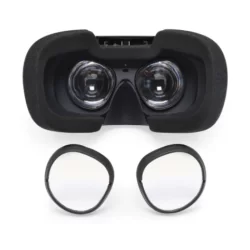

Black Friday 2020 is right around the corner!